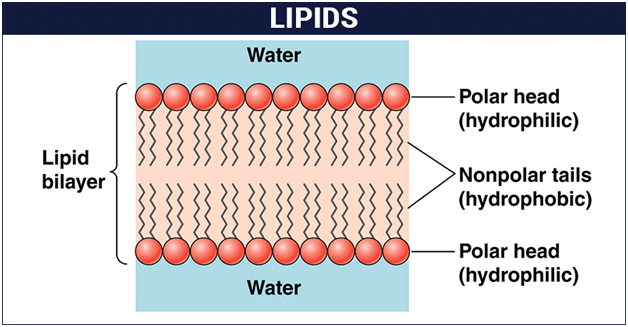Today the topic to be discussed will be lipids or fats. These are organic molecules whose main characteristic is that they are soluble in solvents other than water. They are composed mainly of hydrogen and carbon. Although also, but in a smaller proportion of phosphorus, nitrogen and oxygen.
As we have already mentioned, these are characterized by dissolving in different solvents or liquids. And the vast majority of these are insoluble in water, while they dissolve easily in organic solvents such as ether, acetone and benzene.
Lipids differ from carbohydrates, nucleic acids, and proteins because they do not have a common basic structure. For this reason, there is a wide variety of compounds within this group of biomolecules.
Lipid Classification.
Within the classification of this group composed of biomolecules there is a great variety of types, they can range from the simplest. As is butyric acid, which we can find in butter. Even the most complex lipids such as sphingomyelin, which is found in the nerve sheath. Below we will detail some of the best-known lipid classifications, in order to provide more information on each one.
Fatty acids.
These are the simplest lipids. They are characterized by being made up of two parts: the head and a tail. The head has an acid group (COOH carboxylic group) being hydrophilic, that is. It can live with water, contrary to the tail, which is a string of carbons joined together and hates water, which means that they are hydrophobic.
When it happens that a molecule has a side that is repulsive to water and another that feels affinity for it, it is amphiphilic or amphipathic. This is a common feature in soaps. The link between a 12-carbon fatty acid and lauric acid is widely used in the world of soap and detergent manufacturing.
It is good to note that between the carbons of fatty acids, there can be C=C double bonds or CC single bonds. When there are only unions of the latter, we are in the presence of what are known as saturated fatty acids.
While, when it is the case that a fatty acid has double bonds, it is a monounsaturated fatty acid, this means that it is structured by a single double bond, and they are polyunsaturated when they have two or more double bonds.
Unsaturated Fatty Acids Nomenclature.
As can be seen, the names of these fatty acids are related to the number of carbons in their row and the number of double bonds they have. For example: When a fatty acid has 18 carbons, it is known as octadecanoic. Although it also has a common name which is stearic acid.
On the other hand, when it is a fatty acid with 18 carbons and which also has a double bond between carbon 10 and 9, it is called 9-octadecenoic acid. Or as it is commonly known, oleic acid.
Omega 3, 6 and 9.
This is an old way in which unsaturated fatty acids used to be called, it is the name Omega. This name is given according to the last carbon belonging to the chain. In this way, if we talk about an Omega 3, it means that the fatty acid has a double bond at a distance of 3 carbons from the end.
In the same way, an omega 6 means that the double bond is positioned six carbons from the end, and so on.
Triglycerides.
Its name already tells us that it is the fusion of 3 fatty acids. To be more exact, it is the fusion of a Glycerol with 3 fatty acids, this generates what we know as Triglycerides.
These lie in oils and fats, as they are compounds of triglycerides. The main difference between the two results from their natural state at room temperature: Oils are liquid and fats are solid.
The Phospholipids.
The graphic image of a phospholipid is that of a head with two legs. In the head we can find a phosphate group together with an organic group. While the two legs are fatty acids. This is the key shape in the development of cell membranes.
There are various types of phospholipids, the most abundant in membranes are those known as lecithin, phosphatidylinositol. and phosphatidylserine.
The Steroids.
Steroids are just another class of lipids, with the peculiarity that they are made up of four fused rings. That is, a five-carbon ring and three six-carbon rings, this being one of the differences with fatty acids. Being cholesterol is the most abundant steroid.
Hormones like progesterone, cortisol, and testosterone are also steroids. Similarly, bile salts and acids generated by the liver are steroids derived from cholesterol.
It is possible that when we mentioned steroids you thought of the anabolics consumed by some athletes who practice bodybuilding. These are very similar compounds to testosterone. And its main function is to generate muscles artificially. Obviously, the abusive consumption of these substances can cause both physical and mental problems in the individual.
The Eicosanoids.
These are comprised of a group of compounds that are formed from arachidonic fatty acid. Some of them are leukotrienes, prostaglandins and thromboxanes. Its participation gives rise to immunological processes, blood coagulation and pain.
Lipid function.
If we are talking about a bad reputation, fats or lipids are the first to raise their hands. Well, the vast majority of people consider them harmful to the body and tend to pay little attention. When the reality is that they are as necessary as proteins and carbohydrates. For the proper functioning of our body there must be a balance between the consumption of these fatty acids.
Among its most important functions we find that they are excellent for energy, lipids in the diet are good for providing doses of energy to our body. Since the fat that our body has is the best for energy retention, this being the most effective and easy way to store energy.
Another of the functions of lipids is to form, structure and build cell membranes. In fact, the cell membrane is made up of two layers of phospholipids. Where the hydrophobic faces are facing outwards and the hydrophobic faces are touching each other.
As the last function that we want to highlight, it is that of thermal insulation. We imagine that you have noticed that some plants or bird feathers repel water almost perfectly. The reason for this effect is because under the skin of the animals lies a layer of fat, which favors them when dealing with external temperatures.
We hope that all the information provided in this article has been of benefit to the readers, what we can extract from all this information is that like everything. It is important to maintain a proper balance. Our body is a machine that consumes different types of ” gasoline ” so we must make sure to keep each tank full.
